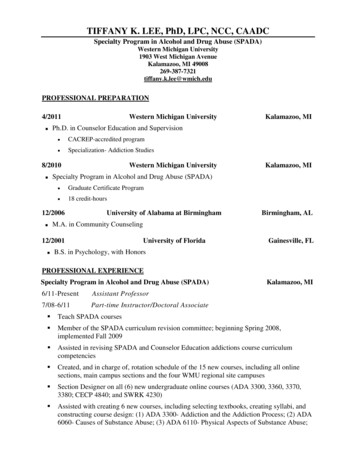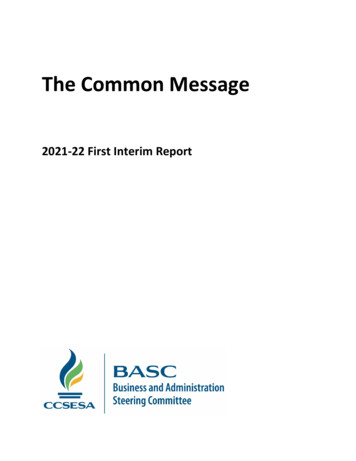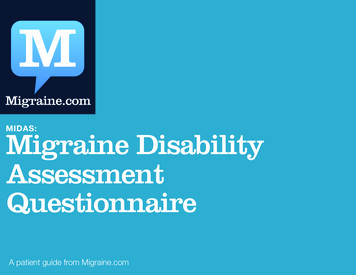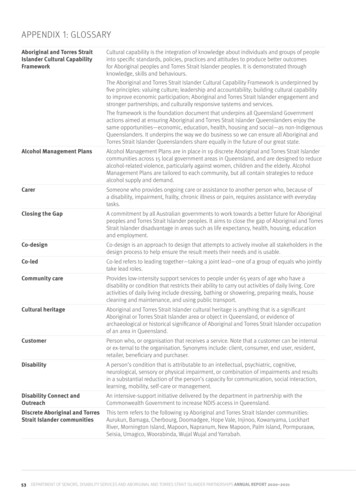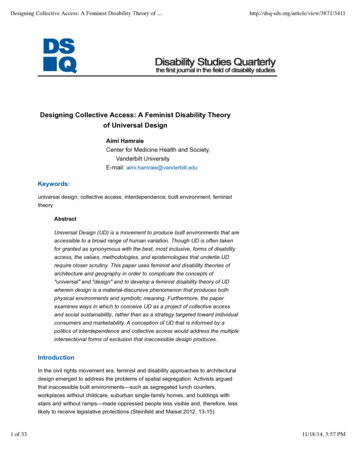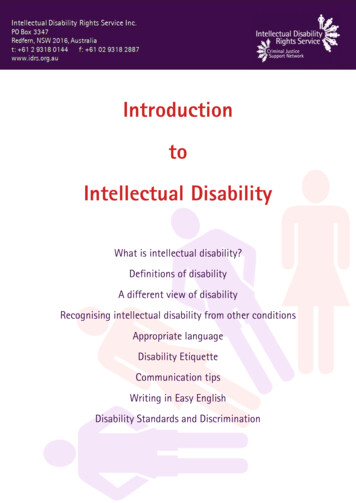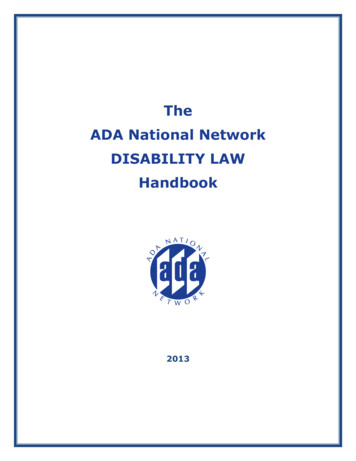
Transcription
TheADA National NetworkDISABILITY LAWHandbook2013
TheADA National NetworkDISABILITY LAWHandbookCreated byJacquie BrennanSouthwest ADA CenterA program of ILRUi
AcknowledgementsThe Southwest ADA Center is a program of ILRU (Independent LivingResearch Utilization) at TIRR Memorial Hermann in Houston, Texas. It isfunded by a grant (#H133A110027) from the Department of Education’sNational Institute on Disability and Rehabilitation Research (NIDRR).NIDRR is not an enforcement agency.Southwest ADA Center2323 S. Shepherd, Suite 1000Houston, Texas he Southwest ADA Center is part of a national network of ten regional ADACenters that provide up-to-date information, referrals, resources, andtraining on the Americans with Disabilities Act (ADA). The centers serve avariety of audiences, including businesses, employers, government entities,and individuals with disabilities. You can reach your regional ADA Center viaa national toll free hotline at 1-800-949-4232 (voice/TTY) or visit the ADANational Network website at www.adata.org.The Southwest ADA Center would like to thank Nancy Horton, LaWandaCook, Alan Goldstein, Sharan Brown, Irene Bowen, Marilyn Golden, KathyGipps, Sharon Brent, Lillian Sutton-Mbionwu, Betty Siegel, Peter Berg, KleoKing, Pam Williamson, and the ADA Knowledge Translation Center at theUniversity of Washington for their assistance in producing this handbook.Copyright 2013. All rights reserved.The information in this book is intended solely as informal guidance and isneither a determination of your legal rights or responsibilities under theAmericans with Disabilities Act or other laws, nor binding on any agencywith enforcement responsibility under the ADA and other disability-relatedlaws.ii
This book is dedicated toWendy Wilkinson.But for Wendy, this little book would not exist.iii
ForewordDisability law is an area of law that overlaps with many other areas of law –including employment law, administrative law, elder law, consumer law,construction law, insurance law, school law, health law, social security law,and civil rights law. Individuals with disabilities are a protected class undercivil rights laws, and it is the one protected class that anyone can join,usually involuntarily, at any point in their lives.It is my hope that this book, which is a very broad brush look at disabilitylaw, will find its way into the hands of both individuals who have disabilitiesand entities that have obligations under various disability laws. This book ismeant to provide basic information about disability rights, as well asresources for finding out more.Jacquie BrennanAttorneySouthwest ADA CenterJacquie Brennan is an attorney with the Southwest ADA Center. A graduate of theUniversity of Houston Law Center, her interest in disability law started with her ninechildren, the youngest five of whom are adopted and have different kinds of disabilities.Jacquie is also the Director of the Paralegal Certificate Program at the University ofHouston. Jacquie is the President of the Board of Directors of A Simple Thread. She alsoserves on the Bioethics Committee of Texas Children’s Hospital.iv
v
TABLE OF CONTENTSAcknowledgements . iiForeword. ivThe Americans with Disabilities Act: An Overview. 1Employment and the ADA . 5State and Local Governments and the ADA . 13Public Accommodations and the ADA . 21Communication and the ADA . 33Transportation and the ADA. 37Service Animals and the ADA . 41Ticketing, Reservations, and the ADA . 45Rehabilitation Act . 51Individuals with Disabilities Education Act (IDEA) . 55Housing . 59Social Security and Disability . 65Air Travel . 73Civil Rights of Institutionalized Persons Act . 93Resources . 95Statute and Regulation Citations . 101vi
This handbook is a broad overview of rights and obligations under federaldisability laws. Individual state laws may impose more stringent obligations.This handbook is intended to inform rather than to advise, and theinformation provided is of a general nature. You should consult an attorneyfor advice about your particular situation.vii
The Americans with DisabilitiesAct:An OverviewWhen did the ADA become a law?The Americans with Disabilities Act (ADA) was signed into law on July 26,1990. Some parts of the ADA didn’t go into effect until after that date togive entities time to comply with the law, but those compliance deadlineshave passed.What kind of law is the ADA?The ADA is a comprehensive civil rights law. It prohibits discrimination onthe basis of disability in employment, state and local government programs,public accommodations, commercial facilities, transportation, andtelecommunications.What is the definition of disability under the ADA?It is important to remember that in the context of the ADA, “disability” is alegal term rather than a medical one. Because it has a legal definition, theADA’s definition of disability is different from how disability is defined undersome other laws.The ADA defines a person with a disability as a person who has a physical ormental impairment that substantially limits one or more major life activity.This includes people who have a record of such an impairment, even if theydo not currently have a disability. It also includes individuals who do nothave a disability but are regarded as having a disability. The ADA also makesit unlawful to discriminate against a person based on that person’sassociation with a person with a disability.What do you mean by “association with a person witha disability”?For example, if I do not have a disability, but I work in an HIV clinic, it wouldnot be legal for someone to discriminate against me based on the fact that Iwork with, or “associate” with, people who have HIV.ADA National Network1Disability Law Handbook
What are major life activities?Major life activities are those functions that are important to most people’sdaily lives. Examples of major life activities are breathing, walking, talking,hearing, seeing, sleeping, caring for one’s self, performing manual tasks, andworking. Major life activities also include major bodily functions such asimmune system functions, normal cell growth, digestive, bowel, bladder,neurological, brain, respiratory, circulatory, endocrine, and reproductivefunctions.What does a “record of” a disability mean?“Record of” means that the person has a history of, or has beenmisclassified as having, a mental or physical impairment that substantiallylimits one or more major life activities, even though the person does notcurrently have a disability.Can you give me an example of someone who has a“record of” a disability without having a currentdisability?Sure. A man, who is in line for a promotion, has a history of cancertreatment, although he is now free of cancer. He is not given the promotionbecause his bosses are worried that, if his cancer returns, he won’t be ableto do the job. He does not, at this point, meet the first part of the definitionof disability because he does not have a physical or mental impairment thatsubstantially limits one or more major life activities. However, based on his“record of” a disability, he is being discriminated against.What does “regarded as” having a disability mean?“Regarded as” means that the person either: Has an impairment that does not substantially limit a major lifeactivity; Has an impairment that substantially limits a major life activity only asa result of the attitudes of others toward them; or Does not have any impairment, but is treated by an entity as having animpairment.ADA National Network2Disability Law Handbook
Can you give me an example of someone who is“regarded as” having a disability?Yes. A woman applies for a job as a customer service representative at adepartment store. Her face is badly scarred from an automobile accident.The interviewer doesn’t want to give her the job, in spite of her skills andexperience, because he thinks customers will be uncomfortable looking ather. She is not substantially limited in any major life activity, but theinterviewer is “regarding her as” if she has a disability.Are all people who have disabilities covered by theADA?I’ll give you the “lawyer answer” – it depends. All people who meet the ADAdefinition of disability are covered by the ADA in general, but they still maynot have rights under particular sections of the ADA. For example, there is asection of the ADA that deals only with employment discrimination. If aperson with a disability is not employed and is not seeking employment,then that person would not necessarily be covered by that part of the ADA,although the person would be covered by other parts of the ADA.Are psychiatric disabilities covered, too?Yes, the ADA definition of disability includes mental, as well as physical,impairments.How many people in the United States have adisability?According to the Survey of Income and Program Participation (SIPP) data,approximately 54 million Americans have a disability.What kinds of things does the ADA cover?The ADA is divided into five sections called “titles.” Each title covers adifferent area. Title I covers employment. Title II covers state and localgovernment programs. Title III covers places of public accommodation. TitleIV covers telecommunications. Title V has several miscellaneous provisionsthat cover things like retaliation and attorney fees.ADA National Network3Disability Law Handbook
I heard there is a new ADA. Is this book about the newADA or the old ADA?Actually, what you might have heard called the “new ADA” is really calledThe ADA Amendments Act – or the ADAAA. After the ADA was originallypassed in 1990, cases started being filed and ending up in courts. Somewere appealed all the way to the U.S. Supreme Court. Rulings by theSupreme Court, as well as lower courts, began to narrow the definition ofdisability. Whether a person had a disability in order to sue became thefocus of most disputes under the ADA. Congress never intended for it to bethat way. The focus of the ADA was supposed to be on access andaccommodation, not on whether the person really had a disability. Congresshad not foreseen the ways in which the courts would narrowly interpret,and ultimately change, the definition.So the ADAAA was passed in 2008 and essentially overturned thoseSupreme Court cases that narrowed the definition of disability. Congressmade clear that the definition must be “construed in favor of broadcoverage of individuals” with disabilities. So rather than this being a “newADA,” it really is just going back to the way Congress meant the ADA to bewhen it was first written and passed in 1990.Where can I get more information about the ADA?There is a Resource Section in the back of this book. You can always callyour regional ADA Center at 800.949.4232 with questions or to request inperson training. You can also learn more about the ADA and your regionalADA Center by visiting the ADA National Network website, www.adata.org.ADA National Network4Disability Law Handbook
Employment and the ADAAs long as I meet the ADA definition of disability, am Icovered by Title I?Not necessarily. Because Title I is about employment, a person must meetthe definition of disability and must also be qualified for the job. There aretwo components to being qualified. First, you need to have the skill,experience, education, and other job-related requirements for the position.For example, it’s legal for an employer to require that a person applying forthe job of a foreign language translator be able to translate a foreignlanguage.The other component of being qualified, in terms of employment, is thatyou must be able to perform the essential functions of the job, with orwithout reasonable accommodation. In other words, getting a reasonableaccommodation could make you qualified for the job. For example, a personwho is deaf may be qualified to the perform the essential functions of acustomer service representative once s/he receives the opportunity to use avideo relay service and specialized computer software as a reasonableaccommodation.What are the “essential functions” of a job?Essential functions are the basic job duties.ADA Regulations say that the following things should be taken intoconsideration when determining whether a job function is essential: The employer’s judgment about which functions are essential; Job descriptions that were written before a job was posted; The amount of time spent performing the function; The consequences of not requiring the person to perform thefunction; The terms of a collective bargaining agreement; and The work experience of others who have had, or currently hold, thesame or similar positions.ADA National Network5Disability Law Handbook
Are all employers covered by Title I of the ADA?No. Title I of the ADA only applies to private employers with 15 or moreemployees, all state and local governments, employment agencies, andlabor unions. Some state and local laws apply to private employers withfewer than 15 employees. Check whether your state, county, or city has ahuman rights act or other law that prohibits discrimination againstindividuals with disabilities.What kinds of employment practices are covered byTitle I of the ADA?All of them – applying for a job, hiring, firing, promotions, compensation,training, recruitment, advertising, layoffs, leave, employee benefits,company functions, and all other benefits, conditions and privileges ofemployment are covered.When should I tell an employer that I have adisability?It depends. Generally, disclosure is discouraged during the applicationprocess, unless you need an accommodation during that process. Once youare hired, you are not legally required to disclose a disability to youremployer unless you request a reasonable accommodation. In light of themyths and stereotypes that still exist about people with disabilities,carefully consider the risks and benefits of disclosure before doing so.Can an employer make me have a medical exam or askquestions about my disability?The answer depends on where you are in the employment process.If you are a job applicant, the potential employer may not ask you to take amedical exam or ask any disability-related questions. The employer may askquestions about your ability to perform specific job functions, includingasking you to describe or demonstrate how you would perform thosefunctions.If you have gotten a conditional job offer, the employer may require you totake a medical exam or answer disability-related questions if the employerrequires the same thing of all employees in the same job category. In fact,the employer can even condition an offer of employment on the results ofADA National Network6Disability Law Handbook
the medical exam, again, so long as the exam is required for everybody.If you are a current employee, the employer may require you to undergo amedical exam only if it is job-related and consistent with business necessity.The employer may also ask questions about your ability to perform thefunctions of the job.What is a reasonable accommodation?A reasonable accommodation is any kind of modification or adjustment to ajob or to the work environment that makes it possible for a qualifiedapplicant or employee with a disability to either participate in the jobapplication process, enjoy equal benefits and privileges of employment, orto perform essential job functions.Can you give me some examples of reasonable andunreasonable accommodations?Examples of reasonable accommodations include: making the workplaceaccessible to and usable by an employee with a disability, restructuring ajob, modifying work schedules, providing qualified readers for individualswho are blind, providing sign language interpreters to people who are deaf,providing periods of leave for treatment, or modifying equipment.Reassignment to a vacant position can also be a reasonableaccommodation, although it is generally considered to be a last resort to besought only if an employee cannot perform the essential job functions evenwith a reasonable accommodation.It is not reasonable for an employer to lower quality or quantity standardsas a reasonable accommodations, and employers are not required toprovide personal use items needed outside the workplace, such aseyeglasses, wheelchairs, or hearing aids.Is telecommuting a reasonable accommodation?Telecommuting may be a reasonable accommodation depending on thekind of job you have and whether the essential functions of the job can beperformed off-site. The Equal Employment Opportunity Commission (EEOC)lists the following factors to be considered when deciding whethertelecommuting is a reasonable accommodation: Whether the employer can adequately supervise the employee;ADA National Network7Disability Law Handbook
Whether certain equipment or tools that cannot be replicated athome are required; Whether face-to-face interaction with other employees is needed; Whether in-person interaction with outside colleagues, clients, orcustomers is necessary; and Whether the job requires the employee to have immediate access todocuments or other information located only in the workplace.If an employer already allows telecommuting for employees, but requiresemployees to work for a specific number of months or years beforebecoming eligible for telecommuting, it might be a reasonableaccommodation for the employer to waive its time requirement foremployees with disabilities. Under these circumstances, the employer haslikely already determined that employees are capable of performing theirjob duties while working from home. If, however, the nature of the job issuch that physical presence at the workplace is necessary, thentelecommuting might not be a reasonable accommodation.Are there any limits on providing reasonableaccommodations?Keep in mind that the person requesting the accommodation must beotherwise qualified for the job and able to perform the essential functionsof the job, with or without reasonable accommodation. Also, employersneed to accommodate only individuals with known disabilities.Employers are not required to provide accommodations if doing so wouldbe an undue hardship on the operation of the business.What is an “undue hardship”?Undue hardship is an “action requiring significant difficulty or expense.” Thisis decided by looking at factors like the nature and cost of theaccommodation compared to the size, the overall financial resources of theemployer, and the structure of the business. If the employer is part of alarger entity, the overall resources of the larger organization are alsoconsidered. For these reasons, cost alone is rarely found to be an unduehardship, except possibly for very small employers. However, if anaccommodation has a significantly negative effect on the employer’sbusiness operation, that may be considered an undue hardship.ADA National Network8Disability Law Handbook
So if the employer can show my accommodationrequest is an undue hardship, am I out of luck?Not necessarily. Even if a particular accommodation would be an unduehardship on the employer, the employer must consider other options to tryto find an accommodation that would not pose an undue hardship. In therare case that the cost of the accommodation poses an undue hardship, theemployer should provide the cost up to the point that there is an unduehardship and then allow the employee the option of paying for the otherportion of the cost. Likewise, if the employer gets money from an externalsource, like a state vocational rehabilitation agency, that would pay theentire cost of the accommodation, it cannot claim cost as an unduehardship.As long as my office is accessible, do the other parts ofthe office, like the kitchen and break room, have to beaccessible?Yes. Employees with a disability should have access to areas where theywork, as well as non-work areas, such as break rooms, lunch rooms, trainingrooms, kitchens, and restrooms, used by other employees, unless providingaccess would be an undue hardship. Even events like conferences andparties held out of the office should be accessible.What if an employer refuses to hire me because the HRperson thinks it wouldn’t be safe to have me around?The ADA lets employers establish standards for determining whether anemployee poses a direct threat to the health or safety of that individual orothers. Direct threat is defined as a “significant risk of substantial harm tothe health and safety of the individual or others if, and only if, that riskcannot be eliminated or reduced by reasonable accommodation.”Deciding that an employee is a direct threat must be based on an individualassessment of that particular employee and must be based on the bestavailable medical or other objective evidence, as opposed togeneralizations, ignorance, stereotypes, fears, or patronizing attitudes. Forexample, it would violate the ADA if an employee with bipolar disorder isfired after disclosing his disability because a supervisor believes people withbipolar are dangerous. This reaction is based on myths and stereotypesrather than the best available evidence.ADA National Network9Disability Law Handbook
When determining whether an employee presents a direct threat, theemployer must determine whether any reasonable accommodations wouldeliminate or reduce the threat.If I use illegal drugs or am an alcoholic, am I coveredby the ADA?The ADA treats individuals who use illegal drugs differently from individualswho misuse alcohol. People who are currently engaging in the use of illegaldrugs are specifically excluded from the ADA definition of “qualifiedindividual with a disability.” Therefore, employers may take action againstthe employee on the basis of drug use without violating the ADA. However,a person who used illegal drugs in the past but went through arehabilitation program is considered to be a person with a disability and isprotected from discrimination.Alcoholism is treated differently under the ADA. A person who currentlyuses alcohol is not automatically denied protection. A person who hasalcoholism may be considered to be a person with a disability depending onwhether the person has an impairment that substantially limits a major lifeactivity. If you have alcoholism and meet the ADA’s definition of disability,you may be entitled to a reasonable accommodation, such as leave fortreatment or therapy. It is not a reasonable accommodation to allow anemployee to consume alcohol, or be under the influence of alcohol, at workif this violates legitimate workplace rules. An employer may discipline oreven fire you if your alcohol use affects your job performance or conduct.And of course, your employer may have a drug-free and alcohol-freeworkplace policy.If I have a disability, can my employer evaluate my jobperformance using the same performance and conductstandards that they use for everybody else?Generally, yes, as long as the same standards apply to everybody. Anemployer can evaluate performance standards, such as how well theemployee performs both essential and marginal job functions and whetherthe employee is meeting basic job requirements like teamwork, customerservice, work output, and product quality. Employers may also evaluate andenforce conduct standards like appearance standards, rules againstdestroying company property, rules about computer and equipment usage,ADA National Network10Disability Law Handbook
and attendance requirements.Your employer may not, however, use standards that are not job-related ifthe standards have the effect of discriminating on the basis of disability.Is an employer allowed to require the samequantitative and qualitative requirements forperformance as it requires for employees withoutdisabilities?Yes. An employee with a disability should meet the same productionstandards as all other employees doing the same job. Employers do nothave to lower production standards as a reasonable accommodation.However, a reasonable accommodation might be required to assistemployees with disabilities in meeting the same production standards. Forexample, an employer may require a secretary who is blind to type 70words per minute as long as the requirement is the same for allsecretaries. While the employer has no obligation to lower this standard, itmay be required to provide certain voice-activated software to enable theemployee with a disability to meet this standard.If an employee with a disability violates a workplaceconduct standard, can the employee be disciplined?Generally, yes, as long as the conduct standard is job-related andconsistent with business necessity, and all other employees are held to thesame standard. For example, if an employee who uses a wheelchair startsfrequent arguments with his/her supervisor or co-workers, s/he may bedisciplined because that conduct is not related to her disability. The ADAdoes not generally protect employees from the consequences of violatingconduct standards, even when the violation is caused by the disability.However, employers may be required to provide reasonableaccommodations to enable the employee to meet the conduct standards.Is it all right for an employer to require an employeeto get or change treatment for a disability to help orcomply with a conduct standard?No. Decisions about medications and medical treatment are generallypersonal medical decisions that take into account a number of factorsADA National Network11Disability Law Handbook
about which the employer may not be aware or have the expertise toconsider. Even if employers just want to help the employee, they shoulddiscuss the unacceptable conduct rather than medical treatments ormedications to treat a disability.Does having a disability protect me from being fired orlaid off?No. Title I of the ADA protects employees from being discriminated againston the basis of disability. It is not a violation for an employer to fire,demote, not promote, reduce hours, or change any other condition ofemployment for some other reason that is not related to your disability. Thesame situation exists with layoffs or reductions-in-force. If your discharge isnot based on your disability, your employer has not violated the ADA.What should I do if my employer has discriminatedagainst me because of my disability?Complaints may be filed with either the EEOC or your state’s designatedhuman rights agency. Private lawsuits are also an option, but you cannot filea lawsuit until after the EEOC or your state’s human rights agency hasinvestigated your complaint and issued a notice that’s referred to as a“Right To Sue Letter.”You can contact the EEOC at:800.669.4000 (Voice)800.669.6820 (TTY)www.eeoc.govADA National Network12Disability Law Handbook
State and Local Governmentsand the ADAWhat is the goal of this part of the ADA?The goal of Title II of the ADA, which covers state and local governments, isreally to make sure that people with disabilities have equal access to civiclife. Individuals with disabilities must be provided an equally effectiveopportunity to participate in or benefit from a public entity's aids, benefits,and services. It essentially covers everything that the state or localgovernment does, including public housing, licensing, all levels of publiceducation, transportation, parks and recreation, detention, emergencyresponse, and police.The City Hall in my town is a very old building and I’vebeen told that, because it is a historical building, itdoesn’t have to comply with the ADA. Is that true?There are two different concepts in this question. The first relates to accessto an historic preservation program and the second is program access in theform of access to city services. Structural changes to facilities that are“historic,” meaning they are listed in or eligible for listing in the NationalRegister of Historic Places or designated as historic under state or local law,might threaten or destroy the historical significance of the property, so theADA might not require those kinds of structural changes. If that’s the case,though, the entity must consider alternatives to such structural changes.These might include providing the government service in another building,or using audiotape or video images to demonstrate the historicalsignificance of the inaccessible portions of the property. If alterations aremade to the property, though, then the changes must conform to the ADAStandards for Accessible Design, which has specific provisions on historicbuildings, to the maximum extent feasible.What about buildings that aren’t really historical, butwere built before the ADA went into effect? Does thelocal government have to make those
2323 S. Shepherd, Suite 1000 Houston, Texas 77019 713.520.0232 800.949.4232 www.southwestada.org The Southwest ADA Center is part of a national network of ten regional ADA Centers that provide up-to-date information, referrals, resources, and training on the Americans with Disabilities Act (ADA). The centers serve a


